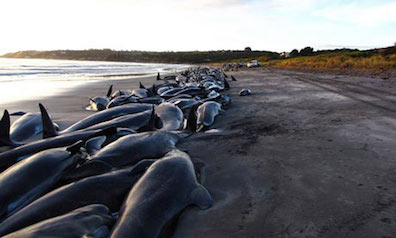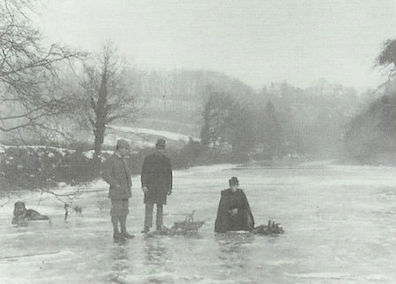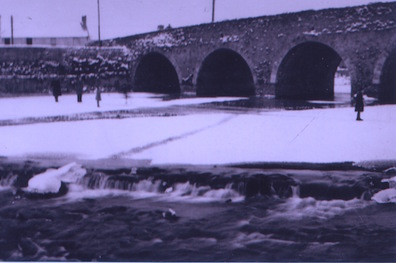After thinking back to the 8th, 9th, and 10th centuries, when
Viking longboats ran up on
the beaches, Stephen apparently turns his mind to the 14th
century, when "Famine, plague, and slaughters" decimated the
Irish population. He mentions two dramatic occurrences from
that time: the stranding of "A school of turlehide whales" in
1331, and an unusually cold winter in 1338 that allowed
Dubliners to play on "the frozen Liffey."
Gifford notes that the beaching of the whales occurred when
Dublin was in the midst of a terrible famine. His source is
the "Dublin Annals" section of Thom's 1904: "a
prodigious shoal of fish called Turlehydes
was cast on shore at the mouth of the Dodder near the mouth of
the Liffey. They were from 30 to 40 feet long, and so thick
that men standing on each side of one of them could not see
those on the other. Upwards of 200 of them were killed by the
people" (2092). Stephen imagines hordes of citizens pouring
out of "the starving cagework city" armed "with
flayers' knives, running, scaling, hacking in green blubbery
whalemeat."
He does not visualize the effects of the plague, but waves of
bubonic plague did sweep across Europe in the 1330s and 1340s.
Gifford notes that some scholars estimate that the disease
killed half of the people living in Ireland. Again, Joyce's
source may be Thom's: "a great pestilence raged
through many parts of the world, and carried off vast numbers
in Dublin" (2092).
Ireland has endured slaughters in many eras, but some of the
worst occurred in the 1310s, when "The Bruce's brother,"
mentioned one paragraph later in Proteus, invaded
Ireland from Scotland and sought
to have himself proclaimed High King. Never lord of more
than parts of Ulster, Edward Bruce waged war from 1315 to 1318
in attempts to expand his dominion, pillaging wherever his
army went, sacking and burning many towns, and massacring the
civilian population (Gaelic and Anglo-Irish alike) in at least
one, Dundalk. So unpopular was he at the time of his death in
1318 that his body was decapitated and quartered, so that the
whole island (and King Edward II in England) could share in
the joy of his passing.
Still one more detail from Thom's 1904 enters
Stephen's thoughts, this one from 1338: "a severe frost from
the beginning of December to the beginning of February, in
which the Liffey was frozen so hard that the citizens played
at foot-ball, and lit fires on the ice" (2096). Stephen
imagines himself moving "among the spluttering resin
fires." The Liffey has frozen at other times, as
the photographs at right document. Gifford notes one freeze in
1739, documented in the 1904 Thom's, hard enough
"that the people amused themselves on the ice" (2096). But
Stephen pretty clearly seems to be concentrating on the early
14th century.
Stephen engages in a kind of time-travel in these vignettes,
thinking of "that I, a changeling," who lived
another life in another time. It is one among many moments in
Ulysses that ponder the possibility of reincarnation or
"metempsychosis." And, more immediately relevant for Stephen,
it offers one more way in which his personal identity is
wrested from protean flux. Past times inform the present, and
racial experiences shape the individual: "a horde of
jerkined dwarfs, my people . . . Their blood is in me, their
lusts my waves."


